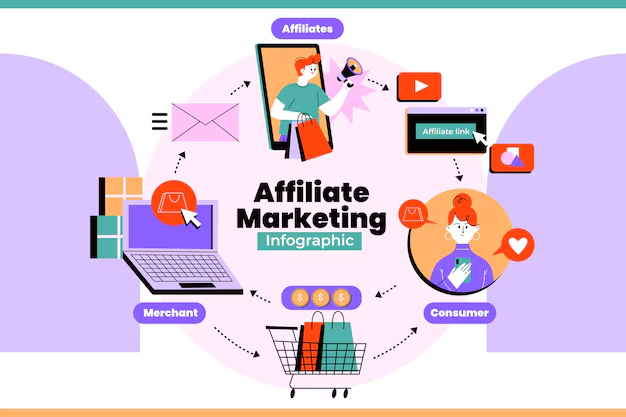
Affiliate marketing is one of those buzzwords that’s thrown around a lot. Simply put, it’s a type of performance based marketing where a business rewards affiliates for bringing in customers through their marketing efforts. Affiliates can be individuals or companies, essentially acting as middlemen who promote the products or services of a merchant and, in return, earn a commission.
Affiliate marketing has an interesting history. It dates back to the mid-1990s when the concept started gaining traction. William J. Tobin, the founder of PC Flowers & Gifts, is often credited with pioneering this model. He launched the first affiliate program in 1994, revolutionizing how businesses approached online marketing. Since then, the method has evolved massively, becoming more sophisticated with the advent of digital technology.
In the world of affiliate marketing, there are three main players: the merchant, the affiliate, and the consumer. The merchant is the business selling the product or service. The affiliate, on the other hand, is the person or entity that promotes the merchant’s offerings. Finally, the consumer is the end user who buys the product or service. Each participant plays a critical role in the ecosystem, working together to drive sales and revenue.
How Affiliate Marketing Works
Affiliate marketing is like a well-oiled machine when done right. Let’s break down the process. Generally, it starts with an affiliate joining a merchant’s program through an affiliate network or directly. They’re given a unique link or code to track their referrals.
Different types of affiliate marketing cater to various strategies. Cost Per Sale (CPS) is straightforward – the affiliate gets paid when a sale is made. Cost Per Action (CPA) rewards affiliates for specific actions like sign-ups or form submissions. Cost Per Click (CPC) focuses on driving traffic to the merchant’s site, paying per click even if no sale happens.
A bunch of tools and platforms can make the affiliate journey smoother. There are tracking platforms like CJ Affiliate, ShareASale, and Rakuten Advertising. Then there are content management systems like WordPress that help affiliates create compelling content. Search Engine Otimisation (SEO) tools, analytics software, and email marketing platforms are also essential parts of the toolkit.
Commissions and payment models are the lifeblood of affiliate marketing. Some merchants offer fixed commissions per sale, while others might offer a percentage. Payment schedules can vary too, weekly, bi-weekly, or monthly. Understanding these elements helps in setting realistic expectations and finding the right programs to join.
Benefits and Challenges of Affiliate Marketing
Affiliate marketing comes with a bunch of benefits. For merchants, it’s like having a massive, commission based sales team. They only pay for results, making it cost-effective. Plus, affiliates often come with their own audiences, which helps in reaching new customer bases without much effort.
Affiliates, on the other hand, love the flexibility. You can work from anywhere, anytime, and have a chance to earn passive income. Whether you’ve got a blog, a website, a YouTube channel, or a social media presence, there’s potential to make money by promoting products or services you believe in.
However, it’s not all sunshine and rainbows. One of the main challenges is competition. Because it’s so accessible, lots of people are jumping on the bandwagon, which makes standing out harder. Additionally, while the potential for passive income is there, it often requires significant time and effort upfront to build an audience and trust.
Scams are another concern. Not all affiliate programs are legit. Research is crucial to avoid fraudulent offers. Look for programs with transparent terms and solid reputations. Joining well-known networks can help mitigate this risk.
Learning from the pros can make a world of difference. Successful campaigns usually involve thorough research, consistent effort, and strategic content creation. It’s essential to adapt and tweak strategies based on what works and what doesn’t. Best practices include being ethical with promotions and maintaining transparency with your audience.
Getting Started with Affiliate Marketing
Choosing the right niche is key. You’ll want to pick something you’re passionate about but also has a good potential for profit. Research trends, check out what’s popular, and see where there’s a gap you can fill.
Joining affiliate programs is the next step. Look for programs related to your niche. Big names like Amazon Associates, ShareASale, and ClickBank are good starting points. Many companies also have their own programs, so browse their websites for affiliate info. Often companies have an affiliate link contained in ‘footer’ at the bottom of their web page.
Creating content that converts is vital. Whether it’s blog posts, YouTube videos, or social media updates, your content should be engaging and valuable. Reviews, tutorials, and comparison posts work well. Remember to use authentic, honest endorsements.
Tracking performance is a game changer. Tools like Google Analytics, affiliate marketing software, and SEO tools will help you monitor what’s working. Pay attention to metrics like click-through rates, conversion rates, and overall sales. Use this data to tweak your strategy, optimize content, and maximize earnings.
You can start your affiliate marketing training, including building your first website, absolutely FREE. Click here.
Join our mailing list
